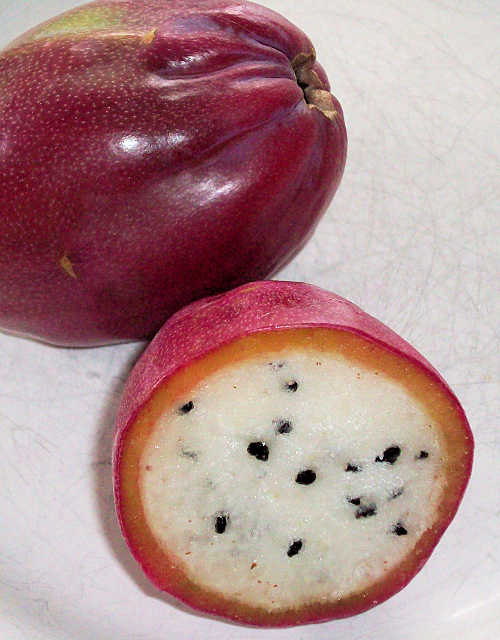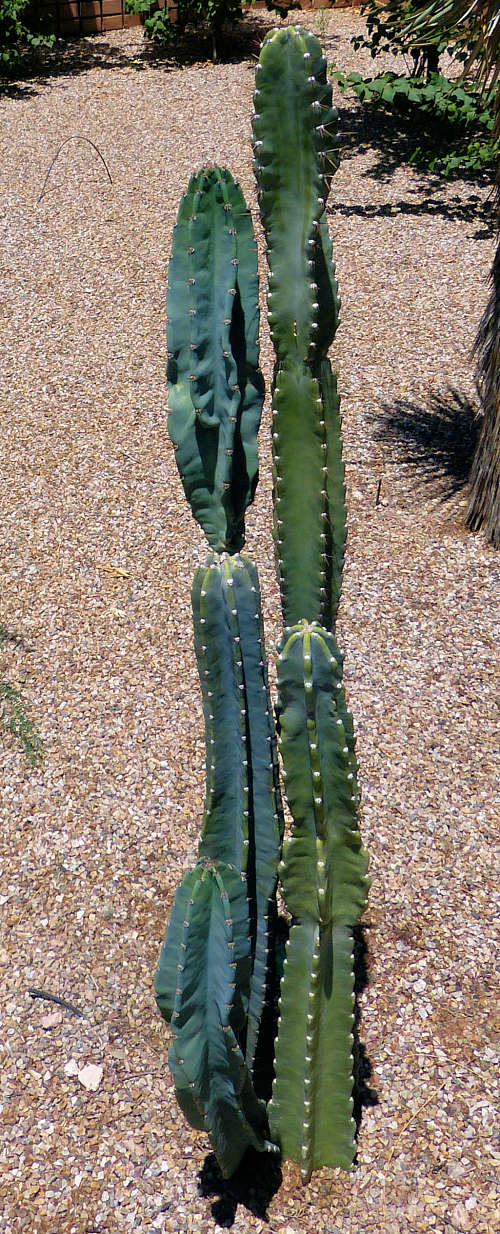Growing Apple Cactus:
Cereus repandus
Back to Fruit, Berries and Nuts
Botanical Overview
A member of the Cactus family (Cactaceae), the genus Cereus contains about 33 species of large, columnar, spiny cacti. Cereus repandus, the common Apple Cactus, produces spineless, edible fruit. Two other species are also known for their palatable fruit: Cereus jamacaru, Jamacaru, and Cereus hildmannianus, Hedge Cactus. All of these have large, spectacular, night-blooming flowers that last only one night. They are grown for their ornamental value as much as their fruit.
Description
Form:
Columnar cactus.
Lifespan:
Perennial.
Evergreen/Deciduous:
Evergreen.
Growth rate:
Slow to fast depending on cultivation.
Mature Size:
12-30' high.
Flowers:
Red buds become 6" diameter, fragrant flowers on long tubes with narrow, white petals,
opening for one night. Only a small amount of nectar is produced.
Bloom:
Up to twice a year, with dates dependant on location and climate.
Self-fruitful:
Self-pollination rates are low and a second plant is needed. Cereus jamacaru and Cereus
hildmannianus can also be used to pollinate this plant. Hand cross pollination from
another plant is used commercially.
Years before fruiting:
From cuttings, 1-2 years; from seed, 4-5 years.
Fruit:
Thornless, round, apple-sized, orange, pink or red skin, white flesh with black seeds
distributed throughout. Tasting sweet, juicy and crunchy when fully ripe, it has been
compared to a cross between shaved ice and melon or kiwi. The rind is not edible.
Months for fruit to ripen:
6 weeks. The fruit become ripe upon a change in color, with violet-red indicating the
best flavor. They often split open, still attached to the trunk, when fully ripe.
Genetic breeding has reduced splitting in commercial cultivars.
Storage after harvest:
Unwashed fruit can be refrigerated up to five days.
Leaves:
None.
Stems:
Blue-green, with clustered spines on undulating ribs, on a columnar, slightly
segmented trunk. Branching columns start at the base of some segments. Spines have been
observed to decrease with age. The number of vertical ribs on a column is highly variable,
from 4 to 12. The number of vertical ribs can change from bottom to top on an individual
segment.
Roots:
This cactus is susceptible to root rot in damp, poorly drained soils.
Wildlife:
The flowers are pollinated by hawkmoths and bats. The fruit attract bats and birds. The stems
of newly planted small cactus specimens can attract rats which can eat and destroy the plant,
starting with the growing tip.
Toxic / Danger:
Clustered spines, but not on the fruit itself.
Origin:
Argentina, Brazil, and Uruguay.
Cultivation and Uses
USDA hardiness zones:
9-11. It tolerates 20°F with tip protection.
Chill hours:
None.
Heat tolerant:
Yes.
Drought tolerant:
Yes.
Sun:
Full morning sun with afternoon part shade.
Planting:
Locate in full sun in well draining soil. This cactus forms thickets in the wild and spacing
should be based on ease of harvest. It can be grown in containers.
Soil:
Very well draining, dry, sandy, with 30% organic material for best fruit production, pH
6.1-7.8 (slightly acidic to slightly alkaline). The presence of salt reduces growth and
flowering.
Fertilize:
Apply a slow release organic fertilizer in early spring.
Water after becoming established:
Every one or two weeks in the growing season. The soil must dry out between waterings. Water
once a month in winter.
In commercial operations, drip irrigation is applied at 10% of the rate used for fruit trees.
Overwatering is signaled by yellowish stems, mushy stems, root rot or a bad smell.
Mulch:
A layer of small gravel can be used, but no mulch is necessary.
First Year Care:
This plant uses a nurse plant in the wild to become established, so provide 50% shade the
first year in temperatures over 90°F. Protect column tips with insulated covers in
freezing temperatures. Do not fertilize in the first year.
Prune:
Only to remove awkward branches.
Litter:
Low. Flowers and unharvested fruit.
Propagation:
Fresh, unrefrigerated seed; stem cuttings, cut in the middle of the segment, allowed to
callous over, and planted right-side up. Cuttings are the preferred way because they are
clones and retain the characteristics of the original plant.
Uses:
Ornamental, edible fruit.
Comments
Cereus repandus is sometimes labeled Cereus peruvianus, or Peruvian Apple Cactus,
although it did not originate in Peru.
In the picture at bottom right, the top segment of the left column has started
a new vertical rib about one-third of the way up.
Another species, Cereus hildmannianus, Hedge Cactus, is also sometimes called
Cereus peruvianus and may be confused with Cereus repandus. C. repandus tends to grow in a
taller tree shape, while C. hildmannianus grows in a shorter shrub shape, branching at the
bottom. These two can hybridize and make identification difficult.
Another fruiting cactus is Cactus Pear:
Opuntia ficus-indica.
Do you have additional information or a different experience for these plants that you would like to share? Email info@GardenOracle.com. All contributions are welcome and appreciated.
Do you have additional information or a different experience for these plants that you would like to share? Email info@GardenOracle.com. All contributions are welcome and appreciated.



Latest update: July, 2022
© 2008-2024 by GardenOracle.com

